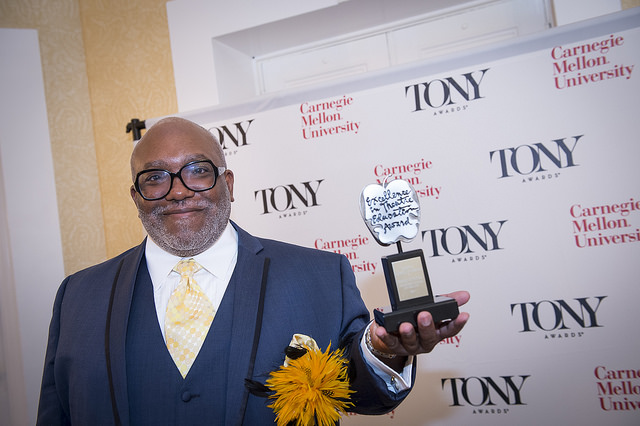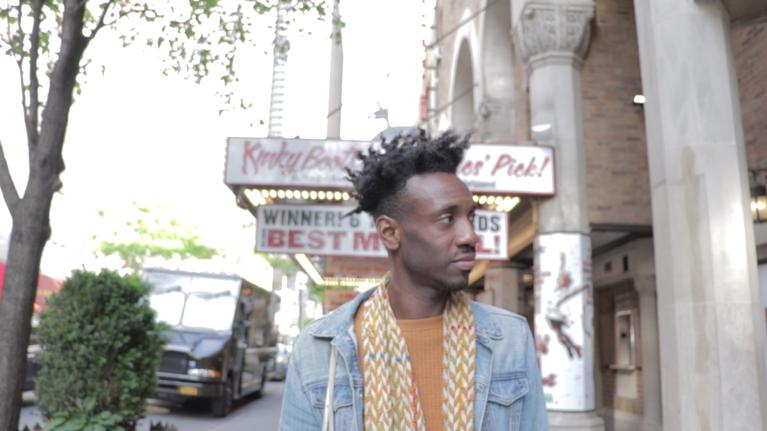

Features
EXCLUSIVE: Theatre Education Tony Award Winner Corey Mitchell
Published
11 years agoon
Fresh off of his win as the inaugural recipient of the Tony Award for Excellence in Theatre Education, Corey Mitchell granted BroadwayBlack an exclusive interview to discuss his success, which emanates from his students. The Excellence in Theatre Education Award is a special honor recognizing a K-12 theatre educator in the U.S. who has demonstrated monumental impact on the lives of students and who embodies the highest standards of the profession. Mr. Mitchell has been teaching for 20 years, 14 of them at Northwest School of the Arts in Charlotte, NC.
BroadwayBlack (BB): What does it mean to receive the very first Tony Award for Excellence in Theatre Education?
Corey Mitchell (CM): It is really overwhelming. The Presidents of the American Theatre Wing and the Broadway League called to let me know I was the first winner. What they kept saying was how important it was to establish someone to be the prototype, or archetype, of what they’re looking for. It’s astounding that I am the standard bearer, and that’s what I carry. At our school, I try to be that person around the city that people look to, to show what is the best in high school theatre. I cannot do this alone; I have a fantastic team of colleagues. Since the Tony Awards, we have had more Technical Directors who have shown interest in wanting to work here {there is currently a job vacancy} and be a part. We know now that what we’re doing is being noticed. It is tremendously humbling. I know that it’s not singular, what it is I carry, but representative of the work that we all do: colleagues, parents, and kids.
BB: What opportunities have presented themselves to you since receiving the Tony Award?
CM: In addition to there being an increase of interest in working for the Northwest School of the Arts, I have already received invitations to be a Keynote Speaker for two theatre organizations, in Florida and South Carolina. It is cool to be offered the opportunity to become a standard bearer in other states.
BB: There has been significant talk about STEM education but perhaps it should be STEAM to include an “A” for Arts. Please share how the Arts are vitally important to a well-rounded student, especially students of color.
CM: What I truly believe is that Arts Education gives students the opportunity to be more than just creative. It is an opportunity to see things from someone else’s perspective. To get behind their eyes and understand where someone comes from and has their life. To figure out where the humanity is and where you, too, are in common with this person. Studying history doesn’t do that. Shows like Hamilton and Rent (which we did in the fall) are able to talk to the students. I graduated college in the early 90s. So when many of my friends were diagnosed as HIV+, it was a death sentence essentially. Rent made it real for my students that AIDS was not an arbitrary thing from the past. We brought in counselors to talk about today’s statistics. As a result, five kids got tested the next day. One said he did a matrix, looking at who’s been with whom around school. That was the real fear and urgency during the AIDS crisis in that time period. Arts Education gives a world perspective that other subjects don’t do. You can talk about it in a Health class, but the theatre turns us into human beings, and more than autobots. Stepping into someone’s shoes makes it real. We were proud that we raised $3500 this year for Broadway Cares on behalf of the school.
BB: Are the Arts especially important for young Black men or would you say the Arts are equally important among genders?
CM: Equal. My father always used to say, “Idle hands are the devil’s workshop.” The Arts are a great opportunity. So often our society is set up such that we expect Blacks, especially boys, to be successful through athleticism. What gets negated is the brain. We are accustomed to thinking in terms of the physicality of Blacks and the intelligence of Whites. Being a vital part of the arts takes away some of the physicality of the “young buck” pathology. Students in musical theatre don’t have time to be idle. Theatre gives them an opportunity to be vital, even those who are not physically impressive. We have a number of things that we do here at Northwest: spoken word, poetry slams, playwriting, and technical theatre. We try to model ourselves after a conservatory. The kids who are really willing to invest into it find their return on investment is incredible.
BB: In 2013, Mitchell took an all-Black adaptation of The Color Purple, with a cast, crew and orchestra totaling 107, to the International Thespian Festival in Nebraska. Mitchell raised more than $171,000 for the production. We asked how he accomplished this herculean feat.
CM: I had been going to the festival for ten years. I’m only not going this year because I will be directing Chicago. I have taken kids every year, but this is the first time I brought a show. So if we were going to go, I wanted to show the best of what it was possible for us to do at Northwest. Doing The Color Purple production was six years in the making. It took me really studying the show and waiting for the right group of kids.
With respect to fundraising, I called Phoenix Entertainment, which was in charge of the second leg of The Color Purple national tour and we rented the actual set that they used on the tour. Wells Fargo helped to jumpstart the fundraising with a sizeable donation. A trucking and moving company did an in-kind donation for all of the shipping. They picked up the set and transported it. They also custom wrapped the two 18-wheelers so it looked like we were on tour. We had an online fundraising campaign in addition to incorporating 16 staff members to help be a part of the production. We were able to bring the cost down per student to roughly a quarter of what it would have been normally. There were also benefactors who sponsored students that weren’t able to afford the costs. In essence, we made the show about community pride.
BB: What was the students’ experience traveling to and performing in Nebraska?
CM: It is the best of the best that gets invited to perform on the main stage in Lincoln, Nebraska. Our production of The Color Purple was the first ever all-Black show in Lincoln on the main stage. To have this group of kids be there and invited to be the Featured Show of the International Thespian Festival was amazing. The Festival is in two different theaters because it is so big, so you don’t see every show that is brought to the main stage. But everyone gets to see the Featured Show and it was incredible. The kids felt like rock stars. For the rest week, every show got compared to The Color Purple. In every workshop, the presenters acted like our students were celebrities and were honored they were willing to take the class. Our students felt legitimized. It was a true confirmation of what I had been saying to them all along: “You’re wonderful. Own the wonderfulness of you.”
There was a standing ovation and the walls were shaking after our performance. Some of the kids in the cast faced significant personal challenges or have less than ideal home lives, but it never affected their performance or attitude. They so deeply believed in the project that nothing stopped them. The other thing I say to them is “there will be times when your life is going to be in a low spot. But I want you to know this is a moment of pure triumph. Try to access what you’re feeling now when you’re feeling low. You’ve worked your way out of adversity before and you can do it again.”
I tell them to “leave it outside.” The school is a haven. It’s not just the kids coming from tough situations. We are a performing arts magnet school and kids from all over the city all come with their particular baggage. I wouldn’t say it’s harder or easier for middle class kids because it isn’t. All are facing some time of challenge but the thing that unites them is their talent and work ethic. The Arts equalize everyone when they’re on stage.
BB: How is your triumph at theInternational Thespian Festival being memorialized?
CM: Grey Hawk films, a production company, is making a documentary that features our production of The Color Purple. I had written a treatment to treat our journey to the International Thespian Festival as a TV documentary series. That was in 2012 when the Democratic National Convention was in Charlotte. Although the treatment wasn’t picked up, Grey Hawk Films followed us. Grey Hawk really went all in telling the stories of 5 students in the cast, paying attention to what we were doing and calling it “the transformative power of the art.” We saw the kids change and blossom; the entire cast, not just the leads. Grey Hawk has been following us since 2012 and now it’s 2015. They’re still following the students, and I joke this might turn into {the movie} Boyhood. The young lady who played Celie came with me as I attended the Tony awards so she could do the Open Call for The Wiz. She got a callback! The Editor of Selma {Spencer Averick} did a cut of the film. The intent is to have the documentary completed for the fall.
Finally, we end with Corey Mitchell speaking to the press after accepting his Tony Award. Listening to him speak with such passion about Arts Education and his students, it is no wonder that he was chosen out of over 4,000 nominees for the award.
Features
Photo Exclusive: Step into The Light with Broadway Black
Published
7 years agoon
February 21, 2019
Have you seen The Light by Loy A. Webb at MCC Theater? If you haven’t, then you need to and Broadway Black has got you. Join us on SUNDAY MARCH 3rd for the BWAYBLK Experience!
Use code BWAYBLACKMCC and pay $35 for any seat on Mar 3 at the 7:30 performance
Not every marriage proposal goes as planned. LOY A. WEBB’s THE LIGHT introduces us to RASHAD and GENESIS on what should be one of the happiest days of their lives, but their joy quickly unravels when ground-shifting accusations from the past resurface in this gripping two-character drama. Can their relationship survive the growing divide between them over who–and what–to believe?
Also, get into this amazing photo series of playwright Loy A. Webb & the cast of her play The Light. Photos by Curtis Brown were taken in the new elegantly designed and strategically welcoming Robert W. Wilson MCC theater space. Located in midtown New York on 52nd and 10th ave (511 W 52nd ST
New York, NY 10019)
On another tip, some really dope creatives will do a talkback after the Saturday matinee performance that you might be interested in attending. Make sure to RSVP.
Panelists include: Nissy Aya, Cristina Pitter, Alicia Rodis & Kavita Mehra
THIS WEEKEND SAT FEB 23rd
LOY A. WEBB’s THE LIGHT at MCC Theater delves deeply into one couples’ reckoning with an encounter with sexual violence that has left audiences asking: as a partner, a family member, a friend, how do we support sexual assault survivors? And what responsibility do artists have to create work that is trauma-informed? On SAT FEB 23 at 4:00 PM for an in-depth conversation about the power of allyship rooted in love and healing – in our lives and on our stages – in the face of trauma.
SAT FEB 23 at 4PM
THE ROBERT W. WILSON MCC THEATER SPACE
511 W52 ST
RSVP HERE.
Features
A Superhero On & Off The Stage, Camille A. Brown Brings ink
Published
7 years agoon
February 5, 2019

Camille A. Brown Photo by Whitney Browne
Camille A. Brown‘s dance company, Camille A. Brown & Dancers, tours nationally and internationally and will be presenting six performances featuring the debut of ink at The Joyce Theater NYC Feb 5-10th 2019.
Propelled by the live rhythms and sounds of traditional African and handmade instruments, Camille A. Brown’s ink celebrates the rituals, gestures, and traditions of the African diaspora. Highlighting themes of brotherhood, community, and resilience, the work seeks to reclaim African American narratives and is the final installment of Brown’s dance theater trilogy about identity.
In addition to her company works, Ms. Brown brings her passion for storytelling to her award-winning choreography for Broadway, Television, and Off-Broadway. Productions include Tony Award Winning Once On This Island, (Drama Desk, Outer Critics and Chita Rivera award nominations), Emmy Award Winning Jesus Christ Superstar Live on NBC, A Streetcar Named Desire, Choir Boy, the upcoming Magic Mike The Musical, PAL JOEY.
We had the chance to probe a little bit into the world of Camille A. Brown, and we’re grateful for the insight and wisdom with which she was able to bless us. Check out the interview below along with an excerpt from ink.
Broadway Black (BB): After forming the idea, what was the process of building ink?
Camille A. Brown (CAB): After the creative process for BLACK GIRL: Linguistic Play, I held a desire to dig even deeper and tell more stories of ritual, gestural vocabulary, and traditions of the African Diaspora. I was immediately drawn to two albums that had a significant impact on me when I was growing up. The Miseducation of Lauryn Hill by Lauryn Hill, and Like Water for Chocolate by Common. I tasked myself with creating a movement language that embodied the same raw authenticity, and vulnerability that fuels those lyrics and music.
As I began to develop the concept for ink, I wanted the dancers to represent superheroes. I couldn’t figure out why I had the urge to play with this idea until I read Question Bridge: Black Males in America. One of the men interviewed said, “I see Black people as comic book heroes because they always keep rising.” That was it! It is about showing that in our basic survival, and natural attributes we have superhuman powers. Powers to shift, overcome, transform, and persevere even within an often hostile environment. The seven sections of ink represent super powers of spirituality, history and heritage, the celebration of the Black female body, Black love, brotherhood, exhaustion, and community.
The process involves a deep collaboration with the dancers and my direction is guided by their choice making.
The space is very organic and fueled by research. My dancers, musicians, dramaturgs, and I are in constant dialogue throughout the process about the work and how it’s progressing. We don’t move forward unless we’re all on the same page.
We are building the work together. As a disclaimer, I let everyone know the process will be exceptionally tedious. Like a fine comb, I go through each beat, gage the temperature of storylines, and make sure the movement and music are always in conversation (whether aligned or in contrast).
BB: What made you want to start your own dance company and how have you sustained?
CAB: I found my love of choreography in college because I struggled with body image, and found that creating my own voice was a safe and empowering space. After graduating, I danced with Ronald K. Brown/Evidence for 5 seasons and during my second year with The Company, a friend from college (Amy Page) sent me a flyer for the Hubbard Street 2 competition which picks 3 choreographers to create work on the Company. I was chosen! That gave me the encouragement to pursue choreography. My first idea was to take an alias like female writers used to do because even at 22, I knew the playing field was not leveled and women (particularly black women) did not get as much exposure as male choreographers. Dance is revealing and vulnerable so taking an alias wasn’t a realistic option. People would have to see me as I am, but I also needed the confidence to withstand the obstacles. Not only that, having a company seemed daunting.
Ron wore so many hats. He was the director, choreographer, teacher, and also took on administrative duties. He never got a break. I wasn’t confident I could handle all of the duties.
I set work on other companies, but soon realized it wasn’t for me. 1-4 weeks working with a Company wasn’t enough time for me to really hone my skills, find my voice, and discover my personal creative process. I desired a more intimate relationship and space with my dancers and collaborators. I had my first show at Joyce SoHo in 2006, and committed to having a company in 2010.
What sustains CABD is my team. I have a company agent (Pamela Green), Managing Director (Indira Goodwine), Company Manager (Michelle Fletcher), and a production team who holds things down.
In the beginning, I was doing ALL the jobs! As time went on, my team slowly formed. It’s really about patience and perseverance. Nothing happened over night and everything is a progression.
BB: How have you had to be a superhero in your own life personally and professionally?
CAB:
Personally
Last year, I had a life-threatening experience. My appendix ruptured on tour. Appendicitis is when they remove your appendix before it ruptures, but mine actually did and the fluid was in my system for at least a week. I survived the “fatal” stage- which the doctors told me isn’t common. This started a very long year and a half which included 4 hospital stints and two surgeries (my second one was in April). This all happened during Once on This Island (I was in the hospital the first week of rehearsal and had my first surgery during tech), Jesus Christ Superstar Live, and my Company touring. I had to access my “superpowers” and push through, but thankfully I had my team and community to help me.
I’m going to be writing about the entire ordeal because it was such an integral part of my life. People see the “success”, but if they only knew the hardships I had to overcome to get to the other side.
Professionally
Being a Black female Choreographer and Director is hard. People ask me to do I feel like I’ve arrived. Absolutely not. I’m still Black and a woman- two underrepresented groups- particularly in theater. The playing field is still not leveled and I’m clear I have to work twice as hard.
I’ve had to build up strength and confidence. It is an ongoing process of gathering those superpowers. In many spaces, I’m sometimes the only woman (I was the only woman on the creative team for Jesus Christ Superstar Live), and the only black person in some rooms.
Recently two black girls at different events asked me the same exact question: How do you navigate spaces where you’re the only one.
It’s quite easy to feel intimated and shrink yourself. I know I have done that in the past. Now, I’ve found if I think about the black women before me in similar spaces, black women who are currently in similar spaces, and the next generation of black women coming after me, it makes me more confident. When it’s not just about you, it becomes a responsibility.
And even when I don’t feel like I have any superpowers, this happens…
and it refuels and encourages me to keep going. Someone is always watching.











1 Comment